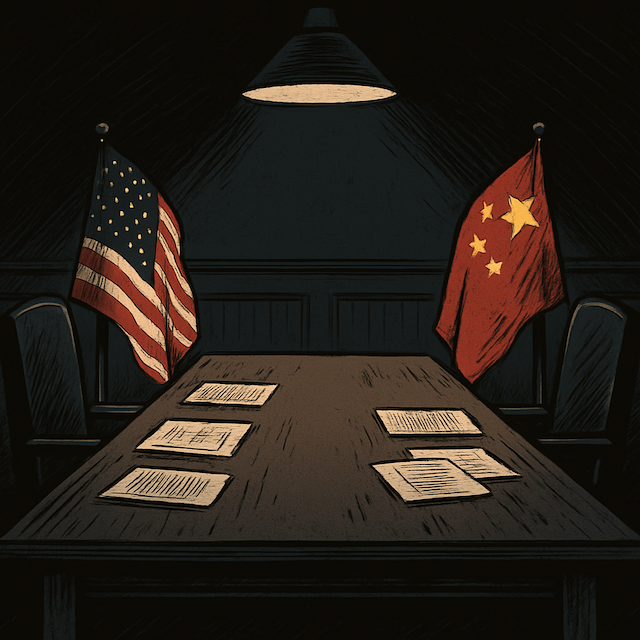What’s Next for China-US Tariffs: Scenarios and Stakes
China and the U.S. are edging back to the negotiating table—but major concessions will decide whether talks succeed or stall.

After months of spiraling tariffs and stalled dialogue, both Washington and Beijing are signaling a potential thaw in trade tensions. Quiet overtures, shifting rhetoric, and market optimism are fueling hopes for a return to the negotiating table—but both sides are still locked in a high-stakes standoff.
Where Things Stand
- China’s Ministry of Commerce has confirmed it is “evaluating” a recent US proposal to restart tariff negotiations.
- This follows President Trump’s sharp tariff hike—raising duties on Chinese imports up to 145%.
- Beijing has responded with tariffs as high as 125% on US goods but has notably exempted key sectors like pharmaceuticals and microchips, hinting at selective flexibility.
- Officials from both countries now describe the diplomatic atmosphere as “open—but cautious.”
What Each Side Wants
China’s Conditions:
- Complete rollback of unilateral US tariffs.
- “Sincerity” from the US—talks must not be a tool of coercion.
- A consistent, respectful message from US leadership.
- Willingness to discuss broader geopolitical issues, including tech bans and Taiwan policy.
- Appointment of a US point person with real authority to negotiate.
US Conditions:
- A “fair deal” with enforceable terms.
- China to make the first public move.
- Assurance that any agreement addresses longstanding US concerns like market access and IP protection.
Market Reaction
News of possible negotiations has already triggered a positive reaction in global markets:
- The S&P 500 rose 1.2% after China confirmed it’s “open” to talks.
- The Chinese yuan stabilised after weeks of decline.
- Investors are betting on at least a temporary truce to relieve pressure on global supply chains.
Potential Scenarios
With both Washington and Beijing signaling interest—but neither willing to blink first—the road ahead is uncertain. Here are the four most plausible scenarios and their implications:
1. Full-Scale Negotiation and Tariff Rollback
In the best-case scenario, both sides enter comprehensive talks, leading to a phased or even full rollback of tariffs. This would signal a major diplomatic breakthrough after months of escalation.
How it could happen:
- The US signals “genuine intent” by easing some of the recent 145% tariff hikes.
- China reciprocates by dialing back its 125% retaliatory duties and expanding exemptions.
- A clear, empowered negotiator is appointed on both sides to oversee talks.
- Broader issues—like export controls and sanctions—are placed on the table.
Outcomes:
- Bilateral trade stabilizes, giving markets a strong boost.
- Supply chains rebound, especially in tech and agriculture.
- Political win for both leaders, but risks domestic backlash over perceived “concessions.”
Reality check:
This scenario requires significant political courage and trust, which are currently in short supply.
2. Partial Agreement or Temporary Truce
A more likely near-term outcome is a narrow, tactical agreement—a freeze on new tariffs, limited reductions, or a deal focused on specific sectors.
How it could happen:
- Both sides seek a face-saving off-ramp ahead of major political events (e.g., US elections, Chinese party meetings).
- Pressure from businesses and global partners intensifies.
- Negotiators strike an interim deal focused on pharmaceuticals, agriculture, or tech.
Outcomes:
- Offers short-term market relief and eases headline risks.
- Avoids further economic deterioration but doesn’t resolve underlying issues.
- Leaves tariffs in place, keeping global supply chains under stress.
Reality check:
This scenario buys time but may set the stage for future tensions if expectations for a broader deal aren’t met.
3. Prolonged Stalemate
Talks stall—or never start—due to mutual distrust and preconditions that neither side is willing to meet. Tariffs stay in place or drift higher.
How it could happen:
- The US refuses to roll back tariffs before talks, citing leverage.
- China insists on prior tariff reductions as a condition for engagement.
- Domestic politics in both countries prioritize optics over compromise.
Outcomes:
- Long-term economic drag for both sides: rising costs, slower growth, and supply chain strain.
- “Decoupling” accelerates, with businesses shifting sourcing and production.
- The IMF and other global institutions may further downgrade economic outlooks.
Reality check:
The longer the stalemate lasts, the harder it becomes to justify the economic pain to domestic audiences.
4. Escalation and Retaliation
If diplomacy fails and tensions rise, both countries could ratchet up tariffs further—or introduce non-tariff measures like tech bans, export controls, or investment restrictions.
How it could happen:
- Talks collapse, and rhetoric intensifies.
- Either country imposes additional duties, or targets critical sectors (e.g., semiconductors, rare earth minerals).
- Geopolitical flashpoints—like Taiwan or sanctions—spill over into trade.
Outcomes:
- Trade flows nosedive, sectors like EVs and AI tech take major hits.
- Third countries get caught in the crossfire, leading to global trade fragmentation.
- Risk of recession rises as consumer prices spike and investor confidence falters.
Reality check:
This is the worst-case scenario—and the most costly for global economic stability.

Both Beijing and Washington are cautiously inching toward the negotiating table, but neither wants to appear weak by blinking first. Until one side makes a visible move—or a third-party breaks the deadlock—expect more posturing, high-level ambiguity, and economic uncertainty.






